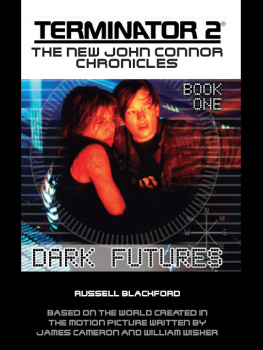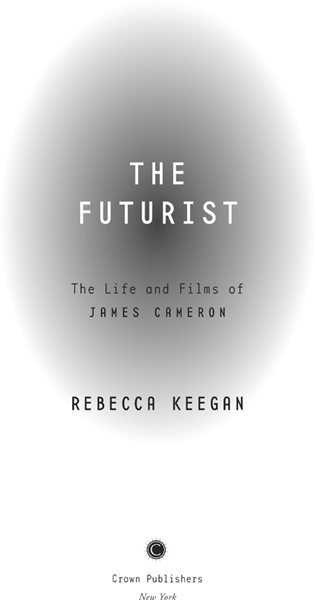10.
Introduction
The Futurist
First I just want to say that were all doomed, the silver-haired director intoned. He was speaking to an Earth Day audience in Santa Barbara, California, in 2000, mocking his own predilection for spinning apocalyptic scenarios. James Cameron has spent his life looking ahead, warily, expectantly, and in the case of his chosen art form, movies, technologically and artistically. And he is constantly entreating the rest of us to join him there, in the perilous world of whats next.
Ever since he left the fate of the planet in the hands of a diner waitress in The Terminator in 1984, Cameron has shown a steady faith in ordinary people to handle extraordinary responsibilities. It could be you who has to save us from the machines, he tells any man orremarkablywoman sitting in a dark theater watching his film. It could be you who has to decide how to live or die on the Titanic.
But there is not much that is ordinary about Camerons own story. Hes a truck driver who directed the highest-grossing movie of all time before he turned forty-four and then ditched Hollywood to spend a decade of his life exploring the deep ocean and the heights of science. Hes a tinkerer and a dreamer who pioneered tools that revolutionized the way stories are told, technologies that a generation of filmmakers now rely upon as surely as they do sound and color. Hes a too-smart kid who spent his adulthood doing things other people called impossible, from filming a movie two and a half miles under the ocean to making a woman an action hero.
More than anything else, Cameron has muscled movies into the digital age, freeing filmmakers to tell stories that had once been possible only in their imaginations. It was he who first showed that computers could deliver not just sharp-edged images, but organic-looking forms, via the twenty computer-generated (CG) shots of a water tentacle rising in The Abyss. With the liquid-metal man in T2, he created a CG character, the T-1000, that stretched the rules of physics and the limits of storytelling. On Titanic, he was making a movie in which the special effects didnt draw attention to themselves but instead disappeared into the reality of a sinking ship, leaving behind only the visceral feelings of beauty, dread, and loss.
But it is Avatar, more than any of Camerons previous films, that has the makings of revolution. He first laid out much of the technology he would use on the film in a digital manifesto in the early 1990s and labored to perfect it over the course of a decade and a half. For this movie, he created cameras that let him peer into virtual worlds and pushed for the industrys adoption of a digital 3-D format. The result is as if the director had broken through the screen, grabbed the viewers hand, and pulled him or her into this exotic, never-seen world called Pandora, a planet of floating mountains, bioluminescent rain forests, and an elegant, tall, blue people called the Navi.
Camerons fancy tools, however, are merely tools, just the latest iteration of the ape flinging the bone in 2001: A Space Odyssey. Technology doesnt come with the wisdom to wield it, whether to make art or to make war. The dark side of our steady march of scientific advancement is a theme Cameron visits in each of his movies and puzzles over in his private life. His first cinematic the end is nigh warning was The Terminator, in which people had unwittingly surrendered our nuclear codes and our very humanity to machines, which waged war against us in 2029. By the time he got to Avatar, twenty-five years later, we were taking our bad habits, our rapacious treatment of the planet Earth, interstellar.
You have to walk fast to keep up with Cameron on one of his film sets. He moves in hyperspeed. After the first time I visited the stages in the Los Angeles warehouse where Avatar was filmed, I learned to wear my sneakers to work. I was there for a Time magazine assignment and was astonished by what I sawa reinvention of how movies are made, a virtual set that existed only inside the directors camera, and in his mind. I knew Cameron to be an innovator, but this was clearly his magnum opus as a future-minded filmmaker. As I watched the director work, I became curious about a man who seemed interested only in doing things that were hard, and in doing them perfectly, and I was determined to follow his intriguing films progress more closely.
I was a fly on the wall during the movies performance-capture shooting and as Cameron teleconferenced with artists at Weta Digital in Wellington, New Zealand, to perfect Avatars 2,500 special-effects shots. I visited his production company, Lightstorm Entertainment, in Santa Monica as he conferred with scientists to shape the mythology of Avatar, and his home in Malibu as he edited the film. I talked to more than fifty of Camerons friends, family members, and colleagues. I met his mother, who is an action heroine trapped in the body of a Canadian grandmother, and spoke to his friend Arnold Schwarzenegger, who has appeared as an iconic villain and hero in three of his movies and spends weekends riding motorcycles with him through the Santa Monica mountains. I talked to Dennis Muren, who helped achieve the stunning advances in computer graphics on The Abyss and T2, and to Peter Jackson, who stood on Camerons shoulders to make the Lord of the Rings trilogy before lending his friend his special-effects house for Avatar. I interviewed Gale Anne Hurd, his second wife and first producing partner; Peter Chernin, the Fox executive who green-lighted Titanic and Avatar; Jon Landau, the producer who enables Cameron to realize his ambitious projects; and Rae Sanchini, who runs his company.
You cant help but come away from spending time with Jim feeling that youre a little bit stupid, Jackson warned me early in my research. Hes got such a sharp mind, hes formidable. Jackson was right. Camerons brain is formidable, fascinating, and equally developed on both sidesthe scientist and the artist. I found a man who has both the ability to tease out esoteric engineering problems, like how a futuristic helicopter should land realistically, and to articulate a clear aesthetic vision to a team of artists, like how a lush alien forest should glow eerily at night. He also showed an uncanny ability to tune out a Greek chorus of naysayers and, just as amazingly, to convince lots of rational people to join him in pursuit of his daunting visions.
One of Camerons oft-uttered phrases is, I knew that would happen! He says it with annoyance when a stunt goes wrong or a piece of technology fails, or with vindication when a championed actor delivers a strong performance or a crazy technical idea takes off. His movies, so many of which depict the future, have turned out to be far more predictive than your average sci-fi fare. Some of the ideas and images contained in themrobotic weaponry, exoskeletal suits for soldiers, massive domestic terrorism, economic ruin, a camera-driven culturehave come true in the years since they were made. So, too, have the filmmaking techniques he evangelized about, despite the skepticism of his colleagues. When he started work on a digital 3-D camera in 2000, most of the industry still thought of 3-D as an entertainment fad best left buried with Smell-O-Vision or disco. By 2010, every animated Disney and Dreamworks movie will be produced in digital 3-D, as will several live-action movies. Based on Camerons track record as a futurist operating in a fictional world, its entirely likely that 2029 will require our best survivalist skills.









